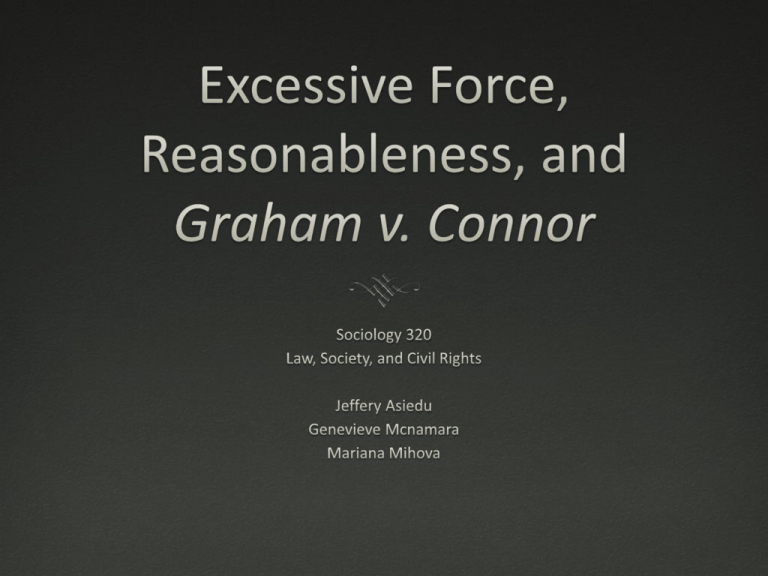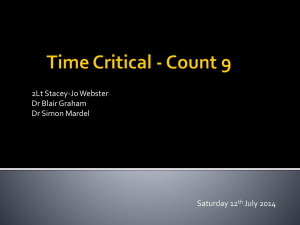Excessive Force, Reasonableness, and Graham v. Connor
advertisement

Overview Definitions History of the Issue Case Background Case Significance Class Connections Our Theories Excessive Force Definition: “the use of force greater than that which a reasonable and prudent law enforcement officer would use under the circumstances is generally considered to be excessive. In most cases, the minimum amount force required to achieve a safe and effective outcome during law enforcement procedures is recommended.” (www.USLegal.com) A pervasive problem. “Reasonableness” Definition: “a test whereby a hypothetical person is used as a legal standard, especially to determine if someone acted with negligence. This hypothetical person referred to as the reasonable/prudent man exercises average care, skill, and judgment in conduct that society requires of its members for the protection of their own and of others' interests. This serves as a comparative standard for determining liability.” (www.USLegal.com) Problematic, because it is vague. The Fourth Amendment Definition: “The right of the people to be secure in their persons, houses, papers, and effects, against unreasonable searches and seizures, shall not be violated, and no warrants shall issue, but upon probable cause, supported by oath or affirmation, and particularly describing the place to be searched, and the persons or things to be seized.” (www.law.cornell.edu) History of Graham v. Connor The issue of excessive force used by the law is quite common, however the Supreme Court has only undertaken very few of these cases. Graham v. Connor is one of the landmark cases that established a precedent to deciding what kind of analysis should be used by the courts in deciding what is considered excessive force in the conduct of police officers during stops and searches. Several Crucial Cases Leading Up to Graham v. Connor The standard used in excessive force cases originated with the 1973 Second Circuit decision of Johnson v. Glick. This was a case in which a pretrial detainee had claimed assault from a prison guard under section 1983. Section 1983 Litigation: - Death Cases – First Amendment Rights - Equal Protection Claims - Denial of Medical Attention – State Created Danger – Wrongful Convictions – Monell Claims (policies and practices that cause constitutional injuries) – - court did not apply the Fourth Amendment and instead clarified that constitutional protection from excessive force “quite apart from any ‘specific’ of the Bill of Rights, application of undue force by law enforcement officers deprives a suspect of liberty without the due process of law” The test for excessive force that came about from the court’s decision characterizes that the use of force must be measured by: - the severity of the crime - any possible danger to the officer - the risk of flight - whether or not the force was applied with malicious intent. Lester v. the City of Chicago (1987) criteria to be used in the seizure of a free citizen should be centered on the “reasonableness” standard rather than a “substantive due process”. “Reasonableness” takes into account that “police are often forced to make split second judgements – in circumstances that are tense, uncertain, and rapidly evolving – about the amount of force that is necessary in a particular situation” Problem with this: -creates an incredible leeway as far as police misconduct is concerned, because the law tends to side with the police, whom are allowed to execute stops following reasonable suspicion based on their subjective observations. The courts tend to side with the police officers due to the “danger and uncertainty inherent in every arrest situation.. deciding whether certain police conduct is reasonable involves making judgments about dangerous situations that judges know little about (Brown, 1991).” Places an incredible amount of confidence in the “split second” judgement of the police officer unreliable way to decide whether the actions of the officer are justified. Case Background November 12, 1984 in Charlotte, North Carolina Dethorne Graham, a diabetic, and friend William Berry Police officer M.S. Connor + 4 responding officers Graham v. City of Charlotte Graham v. City of Charlotte “substantive due process” from Johnson v. Glick decision “[1] the need for the application of force, [2] the relationship between the need and the amount of force that was used, [3] the extent of injury inflicted, and [4] whether force was applied in a good faith effort to maintain or restore discipline or maliciously and sadistically for the very purpose of causing harm.” (Brown, 1259) Fourth Circuit panel affirmed this decision. Graham v. Connor Chief Justice Reinquist: “all claims that law enforcement officers have used excessive force – deadly or not – in the course of an arrest, investigatory stop, or other ‘seizure’ of a free citizen should be analyzed under the Fourth Amendment and its ‘reasonableness’ standard, rather than under a ‘substantive due process’ approach.” (Reinquist, Certiorari) “The Fourth Amendment inquiry is one of ‘objective reasonableness’ under the circumstances, and subjective concepts like ‘malice’ and ‘sadism’ have no proper place in that inquiry.” (Reinquist, Certiorari) Case Significance Reasonableness of a particular use of force: 1. The severity of the crime 2. Whether the suspect poses an immediate threat to the safety of the officers or others 3. Whether he is actively resisting arrest or attempting to evade arrest by flight. Reasonableness is determined by the answer to these questions. The more serious the offense the greater the degree of force will be reasonable. Officers can then consider these factors when deciding what degree of force is justified in a particular set of circumstances. Class Connections Concepts of normality and intersectionality. Human Rights Watch, “Sex Workers at Risk: Condoms as Evidence of Prostitution in Four U.S. Cities.” Kimberle Crenshaw, “Demarginalizing the Intersection of Race and Sex: A Black Feminist Critique of Antidiscrimination Doctrine, Feminist Theory, and Antiracist Politics.” Our Theories Decision made in Dethorne Graham’s original case seems unjust, considering that force was applied completely disregarding his medical condition which was voiced by both Graham and Berry when the police questioned Graham’s “suspicious” activity. Graham and Berry voiced that Graham was carrying a medical card indicating that he is a diabetic. Graham was brutalized by the other police officers called to the scene who refused to acknowledge or check on his medical condition and refused to let Graham drink the orange juice that would have stabilized his blood sugar. The negligence to acknowledge medical need could have put Graham at risk of a diabetic seizure and possibly threatened his life. How Graham could have proceeded… An argument can be made under Section 1983, a statute that was drafted in response to the abuses suffered by African Americans in the Post – Civil War Era, as far as denial of medical attention. This constitutional claim can be called for anything ranging from “deliberate indifference” to “ a serious medical need” for a detainee in custody (Loevy, 2004). The officers exhibited prejudice their own ideas of what constitutes “normal” behavior to assume that Graham was intoxicated, and used that assumption to justify assaulting him. Graham v. Connor Historical Context It is crucially important to acknowledge these factors around Dethorne Graham's case: a black man (Race), living in North Carolina in the late 1980s. (Racist South) The 1980’s was also a time period heavily plagued by crack related drug crimes, which drives the legitimization of the use of force due to the suspicion of Officer Connor, based on his observations it is very possible that he profiled Mr. Graham as someone who fits a racial profile and must further be investigated. The criminalization of the black man especially in the context of the War on Drugs, has had incredible effects on the unparalleled brutalization and incarceration of African Americans. shaped who the American public perceives to be “criminal.” No Protection There is no civil rights safeguard to protect individuals from the police power to target persons according to their own sets of prejudices. This problem persists to current day profiling of people of color with policies such as Stop and Frisk, which have been declared unconstitutional but are still taking place. Recently the Graham v. Connor Case was used in reference to the shooting of Michael Brown, another black teenager that was shot due to the prejudice of police to view urban teenagers of color as dangerous. In conclusion, Graham v. Connor reaffirms our Fourth Amendment rights. According to Darrell Ross, “the court emphasized the overriding function of the Fourth Amendment is to protect an individual’s personal privacy and dignity against unwarranted intrusion by the ‘State’.” Although Graham v. Connor establishes use of the objective reasonableness standard, this does not mean that this standard is evenly applied. This is often left open to interpretation by courts, and even by officers themselves. Does not address issues of police profiling and increased marginalization as a result of one’s belonging to one or more minority groups; does not prevent use of excessive force. Selected Sources Brown, Jill I. “Defining “Reasonable” Police Conduct: Graham v. Connor and Excessive Force During Arrest,” UCLA Law Review 38 no. 5 (1991). The Regents of the University of California. Lexis Nexis Academic. 1257-1286. “Certiorari to the United States Court of Appeals for the Fourth Circuit,” Graham v. Connor. University of Arkansas School of Law. http://law.uark.edu/documents/Bailey-CrimPro-Graham-v.-Connor.pdf Ross, Darrell L. “An Assessment of Graham v. Connor Ten Years Later,” Policing 25 no. 2 (2002). Proquest Social Sciences Premium Collection. 294-319. http://search.proquest.com/docview/211220201?accountid=27495 Sullivan, Eileen. “Supreme Court case to shape Ferguson investigation.” The Big Story. Associated Press. August 21 2014. http://bigstory.ap.org/article/supremecourt-case-shape-ferguson-investigation








